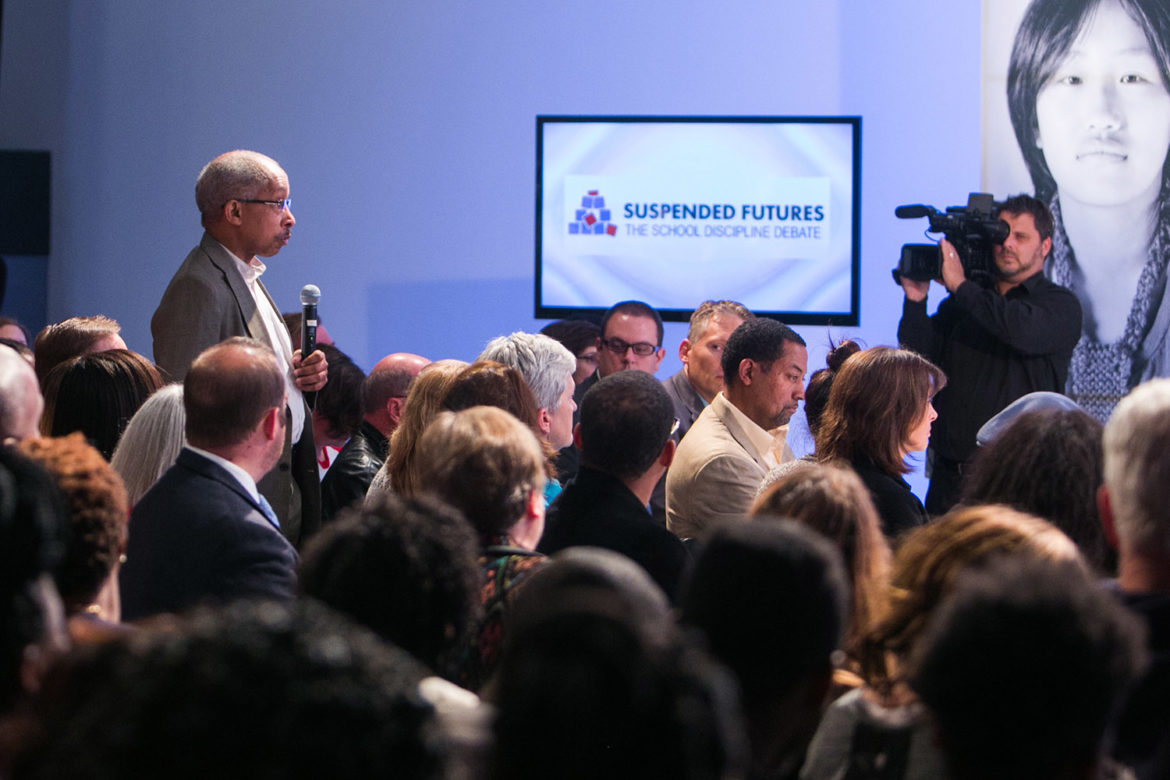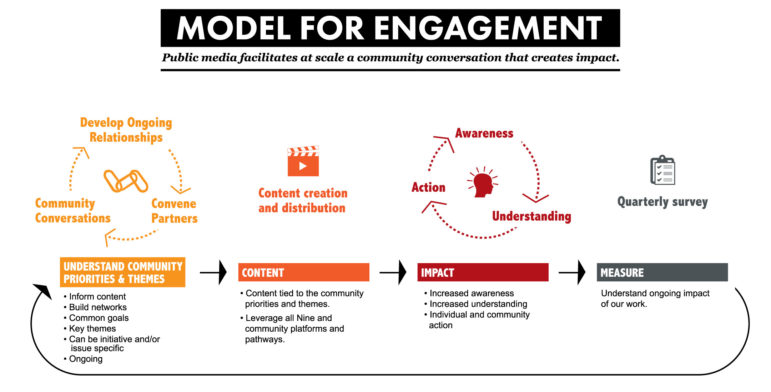Organizational changes are first steps on public media’s path toward engagement

Jason Winkeler
An audience member speaks during an October 2015 Nine Network town hall that examined the link between school discipline and racial bias in the St. Louis region.
This commentary is the first in a series adapted from the Community Engagement Guidebook, produced by the Nine Network with funding from CPB.
Prior to 2004, Gallup’s annual polls typically found a majority of Americans expressed some trust in the media. However, polling data tracking perceptions about the trustworthiness of media have been steadily declining ever since. In September 2016, Gallup reported “now only about a third of the U.S. has any trust in the Fourth Estate.” A headline on the report declared “Americans’ trust in mass media sinks to new low.”
Media experts across the board have outlined a prescription for “fixing” the reputation and credibility of the media industry by creating a sustainable business model to support in-depth reporting that reflects local insights and perspectives. And it just so happens that public media is uniquely positioned to deliver on these criteria.
Researchers of civic engagement have offered numerous recommendations for igniting public participation in community institutions. For example, the Harwood Institute for Public Innovation published The Engagement Path: The Realities of How People Engage over Time—and the Possibilities for Re-engaging Americans. The report outlines steps along a path — from personal reflection to public deliberation — and indicators of progress along the way. Similarly, researchers of public media have presented more pointed proposals for re-envisioning the industry as a more integrative, sustainable and vital player in local communities, and a more prominent voice in the media landscape.
The Harwood Institute, for example, adapted The Engagement Path to focus specifically on its potential for public media. With support from CPB, the institute produced the “Community Engagement Initiative: How Public Broadcasting Can Strengthen Civic Engagement and Deepen Its Local Significance.” The 2007 initiative aimed to “find new ways to make public television and radio stations more significant local organizations, important to and deeply involved in the civic life of their communities.” Through the Community Engagement Initiative, public media began to pivot from community outreach to community engagement.
It led to several groundbreaking initiatives, including Facing the Mortgage Crisis, a 2008 project assisting homeowners facing foreclosures in St. Louis; and, three years later, American Graduate: Let’s Make it Happen, a national effort to improve high school graduation. Both initiatives were led by Nine Network and funded by CPB.
American Graduate represents an ambitious effort to usher stations toward an industry-wide transformation. To date, over 100 public media stations and partners in their communities have worked together to support students who were struggling to complete high school, simultaneously building their own capacity to be relevant and essential.
Given Nine Network’s roles in Facing the Mortgage Crisis and American Graduate, we felt an urgent need to document best practices for developing capacity to pursue this path. Many other public media stations have participated in this vital work, and we called upon them to contribute their experiences and lessons learned. The resulting guidebook, and this series of commentaries, are intended as a practitioner’s guide. Our goals are to help ground stations’ work in the foundational ethos of engagement and provide tactical guidance, along with tools and templates for effectively engaging communities and demonstrating impact.
Getting on the same page
There are various definitions of community outreach, community engagement and community impact floating around the industry. The following definitions ensure that we have a common language and understanding of the concepts and tactics that guide this work.
Community outreach: The process through which we deploy and disseminate materials, content, resources and services to the community.
Community engagement: The process by which we build ongoing relationships for the purpose of applying a collective vision for the benefit of a community. Community engagement primarily deals with the practice of moving communities toward change, usually from a stalled or otherwise similarly suspended position.
Community impact: The process through which we effect measurable change in our audience’s knowledge, attitudes and behavior as a result of viewing or interacting with our content. Community impact strategically leverages engagement efforts to help partners effect change by providing expertise in messaging and content, reaching new audiences and engaging community members in new ways. It translates into increased participation, funding and capacity to serve the community.
The Model for Engagement, developed over the last 10 years by Nine Network, reflects the practices and workflow that can be used to anchor our work to what’s important to our local communities.

Engagement is often thought of as a special project or an activity — something we do. But engagement is an ethos that guides how we approach our work. Once stations anchor their work to this ethos of engagement, it permeates how they approach service to local communities. The model of engagement — listening to the community, reflecting community voices in our content and assessing the impact — can be applied to any sustained work, in any public media organization.
Building capacity for engagement
The integrated nature of the Model for Engagement requires stations to have skill sets, structures and competencies to effectively listen and respond to their communities.
Core functions of station leadership, culture, partnerships, funding, content, exposure and evaluation all play vital roles in deploying this model. Engagement actually starts inside the organization, by developing a shared understanding of how these functions work.
This requires us to think critically about the culture within our stations. To understand how staff members define their work, it’s important to engage them in a self-assessment and discuss their responses across a series of conversations. These exercises facilitate discussion about a station’s assets, culture and aspirations. Participation in the assessment by leaders and staff from different functional areas will ensure that different perspectives about what works well and what needs to be improved will be taken into account, guiding decisions about how the station can become a more effective and essential partner in the community.
Elements that drive impact
Organizational culture and structure can help us build capacity across our stations to be relevant and essential. Here are important considerations as you begin this work:
Leadership is essential.
Leadership ensures that capacity-building is filtered throughout the organization, and that there are concrete opportunities for staff to embrace the ethos of engagement. It is important for leadership to champion public media’s essential value to communities and provide demonstrable examples of how information gathered from the community informs our work.
Engagement takes time and commitment.

Jason Winkeler
Participants in “Looking at Ferguson,” a Nine Network event in August that presented community-created content about the death of Michael Brown, watch the screening in the station’s Public Media Commons.
Effective engagement requires a commitment among staff across the organization. Though some key functions are more involved than others, it is important that the staff works toward the same overarching goals. The work to deliver on the ethos of engagement is continuous; it can take several years to establish the culture, gain momentum and realize impact.
Employ a cross-functional approach.
Regular collaboration among cross-functional teams is essential to achieve the desired impact. Beyond their day-to-day work, teams should review their progress together and discuss what they are learning. This practice helps teams plan more efficiently, share ideas and collaborate in a way that ensures impact.
Though specific staff may lead community engagement efforts, employees across the organization should be involved in various stages of the work, including planning and implementation. Over time, it should become apparent that the role of community engagement is not just a job title, but an organizational imperative.
Constantly re-assess your progress.
Regularly look for ways to improve the work by taking time to plan, implement, assess and adjust — and then repeat the process. You are building a learning community that is strategically working toward a shared goal, and taking risks and learning from mistakes. Re-assessment also provides an avenue for recalibration.
Listening to the community requires each station to be nimble. As you engage with partners and community members, you become aware of new information that may add to, refine or even redirect your original plan. Re-assessment should also be done with partners, not just within a station.
Dedicate a staff person to lead partnerships.
Generally, the best practice is to designate one senior person to manage partnership and engagement efforts and be accountable for the strategy that guides this work. This allows the staff member to consistently gather and coordinate the flow of information from the community to the station, and from the station to the community. By working at a senior level, this staff person builds ties across the organization and ensures that engagement is indeed regarded as an organizational imperative.
Content creation is an essential element of engagement.
Through the engagement process, you’ll learn which issues are most important in your community. Public media’s unique contribution is the ability to create content that makes these issues visible to a wide audience across multiple platforms. Since the engagement model relies on a cross-functional approach, content producers work with engagement staff to understand the issues and share information about them.
Distribute content to the widest possible audience.
Think beyond the avenues available to a public media organization with broadcast and digital platforms. Partners ensure that information reaches into the community in ways that might not be possible for your organization alone.
Sharing content with partners also demonstrates your value to them and affirms that you are listening and understanding the issues. Think strategically about how to share the value and impact of your work on a consistent basis.
Collect data and analyze it.
To assess and communicate the impact of this work, stations need the skills and capability to quantitatively and qualitatively analyze and interpret data in a broad context. It’s important to adapt and use data-collection tools, analyze data and prepare clear and concise summaries of findings to share across the organization and externally.
Staff with these skills may already work in your station, so consider an assessment of skills that would identify those who could take on this work. For example, development staff might be adept at designing logic models; these teammates could support the strategic evaluation design. The information and analyses can strengthen the quantity and quality of the work, and clearly demonstrate to funders the impact of community engagement.

Galmiche
If hiring an evaluation professional is possible, look for mixed-method researchers with social science backgrounds such as sociology, anthropology and public health. Retaining a staff person to oversee evaluations improves your in-house capacity for successfully evaluating your work. Funders are seeking tested and valid results, not just counts of episodic activity.
Additional options include hiring an intern or practicum student from a local university, or contracting with a third-party evaluation service. Review partners’ and funders’ websites for impact reports. If you find one that is particularly compelling and accessible, get in touch with the firm that conducted the research.

Shaw
Identifying and making the internal changes needed to effectively engage your community takes time. The process might seem onerous, but it allows you to build a station-wide commitment and approach. As the benefits of this work start to emerge, recognition of its value to local communities — and to the nation as a whole — will help build trust and ensure public media’s future viability in this changing media landscape.
Nine Network CEO Jack Galmiche and Senior VP Amy Shaw developed groundbreaking engagement strategies for public media through their leadership of the St. Louis station and through the national American Graduate initiative. They wish to acknowledge the contributions of former colleagues Shelly Williams and Courtney Dowdall in producing the guidebook from which this commentary was adapted, and CPB’s role in supporting the publication. For more information about the guidebook, contact Amy Shaw.






